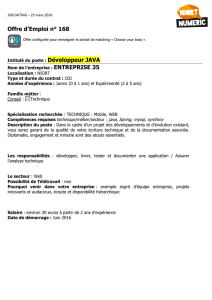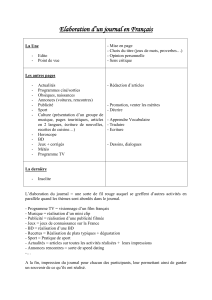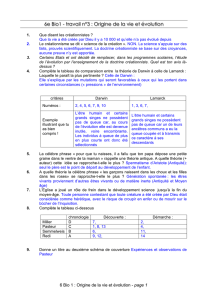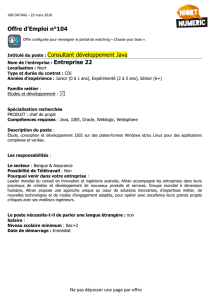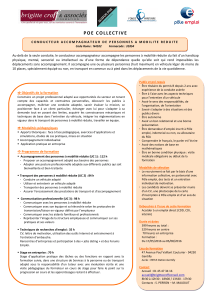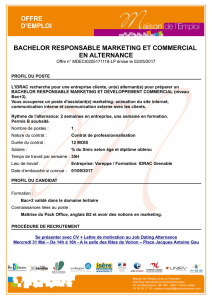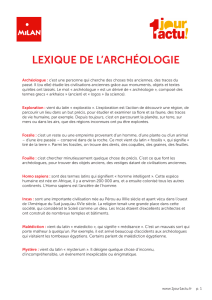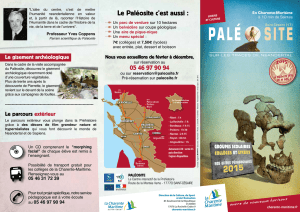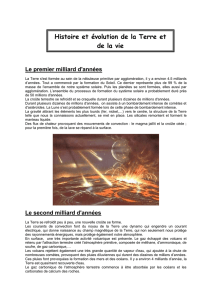Direct radiocarbon dating and stable isotopes of the neandertal
publicité
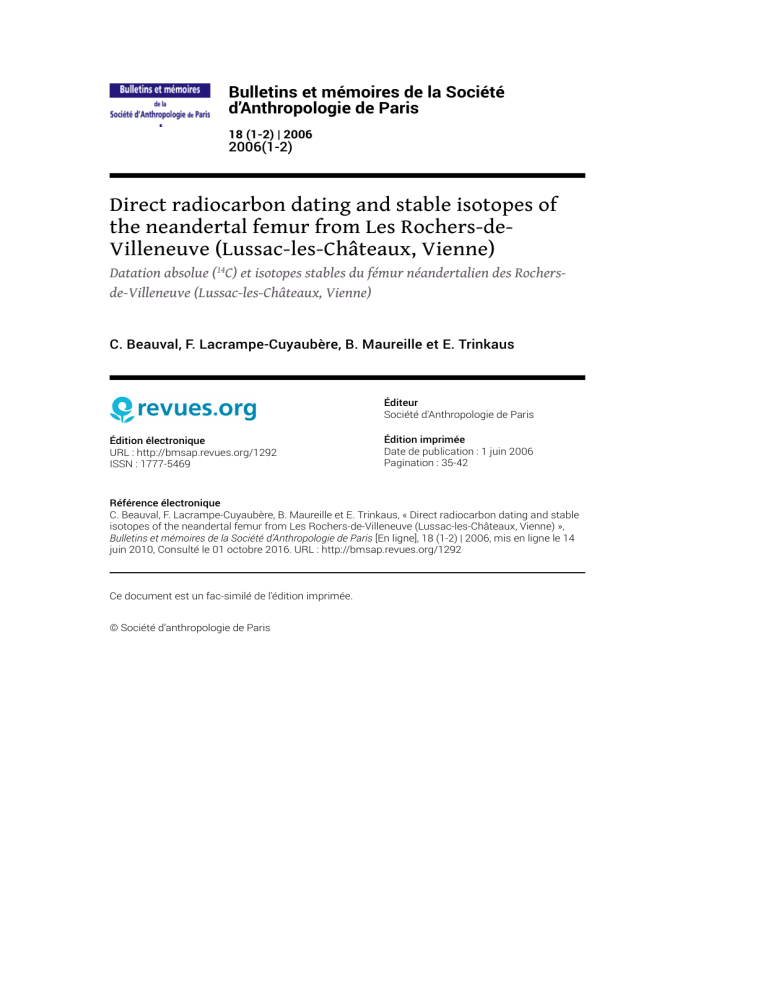
Bulletins et mémoires de la Société d’Anthropologie de Paris 18 (1-2) | 2006 2006(1-2) Direct radiocarbon dating and stable isotopes of the neandertal femur from Les Rochers-deVilleneuve (Lussac-les-Châteaux, Vienne) Datation absolue (14C) et isotopes stables du fémur néandertalien des Rochersde-Villeneuve (Lussac-les-Châteaux, Vienne) C. Beauval, F. Lacrampe-Cuyaubère, B. Maureille et E. Trinkaus Éditeur Société d'Anthropologie de Paris Édition électronique URL : http://bmsap.revues.org/1292 ISSN : 1777-5469 Édition imprimée Date de publication : 1 juin 2006 Pagination : 35-42 Référence électronique C. Beauval, F. Lacrampe-Cuyaubère, B. Maureille et E. Trinkaus, « Direct radiocarbon dating and stable isotopes of the neandertal femur from Les Rochers-de-Villeneuve (Lussac-les-Châteaux, Vienne) », Bulletins et mémoires de la Société d’Anthropologie de Paris [En ligne], 18 (1-2) | 2006, mis en ligne le 14 juin 2010, Consulté le 01 octobre 2016. URL : http://bmsap.revues.org/1292 Ce document est un fac-similé de l'édition imprimée. © Société d’anthropologie de Paris Bulletins et Mémoires de la Société d’Anthropologie de Paris, n.s., t. 18, 2006, 1-2, p. 35-42 DIRECT RADIOCARBON DATING AND STABLE ISOTOPES OF THE NEANDERTAL FEMUR FROM LES ROCHERS-DE-VILLENEUVE (LUSSAC-LES-CHÂTEAUX, VIENNE) DATATION ABSOLUE (14C) ET ISOTOPES STABLES DU FÉMUR NÉANDERTALIEN DES ROCHERS-DE-VILLENEUVE (LUSSAC-LES-CHÂTEAUX, VIENNE) Cédric BEAUVAL 1, François LACRAMPE-CUYAUBÈRE 1, Bruno MAUREILLE 2, Erik TRINKAUS 3 ABSTRACT Direct radiocarbon dating of the Neandertal femoral diaphysis from the Rochers-de-Villeneuve (Lussac-lesChâteaux, Vienne) has yielded an age of 45,200 ± 1,100 14C years B.P. (OxA-15257) [48,455 ± 1,878 cal. years B.P.], and stable isotope values of δ13C = - 19.0‰ and δ15N = 11.6‰. The direct radiocarbon date makes it the oldest directly dated European Neandertal specimen, even though others have securely associated radiocarbon dates in the same time range. The stable isotopes are similar to those for other OIS 3 European Neandertals and indicate a relatively high trophic level for this individual. Keywords: Neandertal, Mousterian, hyena, dating, isotope, carbon, nitrogen. RÉSUMÉ La diaphyse fémorale néandertalienne des Rochers-de-Villeneuve (Lussac-les-Châteaux, Vienne) a été datée à 45 200 ± 1100 14C ans B.P. (OxA-15257) [datation calibrée : 48 455 ± 1878 ans cal. B.P.] par la méthode du 14C en SMA. Les valeurs associées des isotopes stables du carbone et de l’azote sont de - 19,0 ‰ pour le δ13C et 11,6 ‰ pour le δ15N. Ce spécimen est ainsi le plus vieux Néandertalien daté directement même si, pour un intervalle d’âge comparable, d’autres dates 14C de fossiles sont connues et acceptées. Les isotopes stables sont similaires à ceux des Néandertaliens européens du stade isotopique 3 et indiquent un niveau trophique relativement élevé pour le Néandertalien des Rochers-deVilleneuve. Mots-clés : Néandertal, Moustérien, hyène, datation, isotope, carbone, azote. 1. Archéosphère, Domaine du Haut-Carré, Bâtiment C5, 351 cours de la Libération, 33405 Talence CEDEX, France. 2. UMR 5199, Laboratoire d’Anthropologie des Populations du Passé, Université Bordeaux 1, avenue des Facultés, 33405 Talence CEDEX, France, e-mail : [email protected] 3. Department of Anthropology, Campus Box 1114, Washington University, Saint Louis MO 63130, USA. Manuscrit reçu le 11 mai 2006, accepté le 10 octobre 2006 36 C. BEAUVAL, F. LACRAMPE-CUYAUBÈRE, B. MAUREILLE, E. TRINKAUS VERSION FRANÇAISE ABRÉGÉE Durant la campagne de fouilles de l’été 2002, un fragment de diaphyse fémorale néandertalienne était mis au jour dans le gisement des Rochers-de-Villeneuve (Vienne, France). La datation du lithofaciès J livrant la pièce était de 40 700 ± 900 14C B.P. (Beta-177 765) [44 392 ± 876 cal. B.P. (CalPal version 1.4, www.calpal.de)] sur la base d’un morceau de radius d’hyène des cavernes, pièce située à proximité du fémur néandertalien (Beauval et al. 2005). Ce fémur pouvait donc être classé parmi les Néandertaliens les plus récents d’Europe de l’Ouest (Beauval et al. 2005). Nous avons donc décidé de dater directement le fémur humain. Pour cela, un échantillon de 620 mg a été prélevé au niveau de l’os cortical à proximité de la cavité médullaire sur la moitié latérale de la diaphyse (fig. 1). Il a été soumis à l’Oxford Radiocarbon Accelerator Unit (ORAU) pour obtenir une datation au 14C en SMA. Ce laboratoire utilise de plus une technique (l’ultrafiltration) qui permet d’éliminer le collagène dégradé ainsi que les contaminations potentielles (Bronk Ramsey et al. 2004 ; Higham et al. 2006b). Alors, les dates obtenues sont généralement plus anciennes de quelques millénaires que celles estimées avec d’autres techniques (Jacobi et al. 2006). Les détails de l’analyse et les résultats pour le fémur des Rochers-de-Villeneuve 1 sont donnés dans le tableau 1. La datation est de 45 200 ± 1100 ans B.P. (OxA-15257). La valeur calibrée (avec CalPal version 1.4, cf. supra) est de 48 455 ± 1878 ans B.P. 4. C’est donc actuellement le plus ancien néandertalien daté directement (tabl. II) et il se rapporte au stade isotopique 3. Si l’âge du fémur est plus ancien que celui obtenu sur le radius d’hyène, c’est probablement en partie la conséquence des techniques de datation utilisées. Rappelons par ailleurs que ce niveau J correspond à un ancien repaire d’hyène et que le fémur des Rochers-deVilleneuve 1 montre des stigmates liés à l’activité de ces carnivores. 4 Les dates cal. B.P. présentées ont été calculées avec CalPal version 1.4 (www.calpal.de). Conscients du débat sur la pertinence de ces données « calibrées » (Mellars 2006a, b contra Turney et al. 2006 ; Van der Plicht et al. 2004), nous les indiquons ici pour permettre au lecteur une comparaison plus aisée des données. En plus de la datation, l’analyse nous permet de connaître les valeurs des isotopes stables du carbone et de l’azote pour ce fémur. Le δ13C est - 19,0 ‰ et le δ15N est de 11,6 ‰. Le radius d’hyène du niveau J a un δ13C de - 18,6 ‰. À partir de la compilation de données publiées sur les δ13C et δ15N de différents fossiles du Pléistocène supérieur, nous pouvons comparer la position du fémur des Rochers-de-Villeneuve avec celle d’autres spécimens du stade isotopique 3 (fig. 2, 3). Il est maintenant connu (Bocherens et al. 1991 ; Richards et al. 2000 ; Bocherens et al. 2005), que les Néandertaliens ont alors des positions voisines de celles des carnivores des gisements considérés. Le δ15N reflète généralement le niveau trophique, augmentant de 3 ‰ à 5 ‰ entre chaque échelon de la chaîne alimentaire (Bocherens et al. 2005), bien que des facteurs non alimentaires puissent également interagir (Drucker et al. 2003 ; Richards, Hedges 2003 ; Drucker, Bocherens 2004). Le fémur des Rochers-deVilleneuve 1 a une valeur parmi les plus élevées chez les Néandertaliens, à proximité de deux autres spécimens provenant du gisement des Pradelles (ou Marillac, Charente). Le δ13C est négatif. Il est plus faible chez les Néandertaliens que chez les fossiles du Paléolithique supérieur (même si la variabilité des deux groupes se recouvre). Il est probable que le δ13C varie à la fois en fonction de l’environnement des proies et des niveaux trophiques des animaux étudiés. La valeur de - 19,0 ‰ de Rochers-de-Villeneuve 1 est proche de celle du radius d’hyène déjà étudié et se place au milieu de la variabilité des Hommes modernes du Paléolithique supérieur et au niveau des plus fortes valeurs des Néandertaliens du stade isotopique 3. Des analyses complémentaires sur les restes de faune de ce gisement sont donc nécessaires pour une interprétation plus fine de ce résultat. INTRODUCTION The 2002 discovery of a partial Neandertal femoral diaphysis at the Rochers-de-Villeneuve (Vienne, France) (Beauval et al. 2005) has added to our sample of relatively late Neandertal remains in western Europe, reinforcing the morphological pattern of Neandertal (and archaic Homo generally) femoral morphology while suggesting a shift in biomechanically relevant parameters among later Neandertal populations. However, the precise age of the specimen has remained uncertain, since it was previously dated by association within Level J within the site. DIRECT RADIOCARBON DATING AND STABLE ISOTOPES OF THE NEANDERTAL FEMUR FROM LES ROCHERS-DE-VILLENEUVE (LUSSAC-LES-CHÂTEAUX, VIENNE) Level J is a palimpsest of Middle Paleolithic human activity, indicated by lithic remains and processed herbivore remains, and hyena denning, indicated by gnawed and etched bones, shed deciduous hyaenid teeth, and coprolites. The previous radiometric dating was provided by an AMS (accelerator mass spectrometry) date of 40,700 ± 900 14C B.P. (Beta-177 765) [44,392 ± 876 cal. B.P. (CalPal version 1.4, www.calpal.de)] on a hyena radius from an adjacent square of the same level (Beauval et al. 2005). However, given the possibilities of the mixing of materials in any Pleistocene stratigraphic level, especially one with alternating use of the site by humans and large carnivores, it was decided to directly radiocarbon date the Rochers-de-Villeneuve Neandertal femur. To this purpose, a small piece of cortical bone (fig. 1) was removed from the endosteal side of the lateral femoral diaphysis at the proximal postmortem break near midshaft and submitted to the Oxford Radiocarbon Accelerator Unit (ORAU) for AMS dating (for full technical details, see: Bronk Ramsey et al. 2004; Higham et al. 2006b). In addition to standard AMS dating, ORAU employs a sample preparation technique for bone samples using ultrafiltration, which sorts the derived collagen by molecular weight and thereby removes diagenetically degraded collagen and additional potential contamination (Brown et al. 1988; Fig. 1—Medial view of the Les Rochers-de-Villeneuve 1 femur (proximal extremity at the top) and position of the two samples (A: mtDNA sampling, Beauval et al. [2005]; B: 14C datation sampling, this study). Fig. 1 - Les zones des deux prélèvements sur le fémur des Rochers-de-Villeneuve 1 (A : pour l’ADNmt, Beauval et al. [2005] et B : pour la datation absolue au 14C). 37 Bronk Ramsey et al. 2004; Higham et al. 2006b). When applied to Late Pleistocene samples previously dated by standard pretreatment techniques, this technique usually provides determinations several millennia older (Jacobi et al. 2006) than the former results and/or with smaller error factors (Higham et al. 2006b), differences attributed to improved pretreatment rigor. RADIOCARBON DATING RESULT The 620 mg sample of bone from the Rochers-deVilleneuve 1 femur yielded 3.6% collagen (tabl. I). This produced a δ13C value of - 19.0‰ and a carbon: nitrogen (C:N) atomic ratio of 3.25. The δ13C value falls in the middle of acceptable ranges for bone, and the C:N ratio is in the middle of the acceptable range of 2.9 to 3.5 for well-preserved bone (De Niro 1985; Bronk Ramsey et al. 2004). The resultant date of 45,200 ± 1,100 14C years B.P. (OxA-15257), despite its relatively large standard error, should therefore be an accurate estimate of the age of the Rochers-de-Villeneuve 1 Neandertal individual. When the age is adjusted using CalPal version 1.4, a calendrical equivalent age of 48,455 ± 1,878 cal. years B.P. 5 is attained. This age for the Rochers-de-Villeneuve 1 femur is older than the previous date on a hyena bone, even at two standard deviations for both of the dates for the uncalibrated dates in radiocarbon years. However, the difference is not markedly greater than the differences of a couple of millennia sometimes encountered when samples are re-dated using ultrafiltration and AMS 14C dating. Moreover, the resultant calendrical equivalent dates are not significantly different from each other at two standard deviations. It is therefore likely that the human femur and the hyena denning activity, as indicated by the hyena damage to the human femur (Beauval et al. 2005), were contemporaneous, but that the age of the alternating occupations in Level J at Rochers-de-Villeneuve is slightly older than previously assessed. This result makes the Rochers-de-Villeneuve 1 femur the oldest directly radiocarbon dated Neandertal 5. The cal. B.P. dates presented have been calculated using CalPal version 1.4 (www.calpal.de). Being aware of a debate on the pertinence of the utilization of such calibrated dates (Mellars 2006a, b contra Turney et al. 2006; Van der Plicht et al. 2004), we give them to allow, if interested, more easy comparisons. 38 C. BEAUVAL, F. LACRAMPE-CUYAUBÈRE, B. MAUREILLE, E. TRINKAUS specimen. Only the Feldhofer 1 and 2, Vindija 208, and three specimens from Sidrón (table II) have provided reliable direct radiocarbon dates for Neandertal specimens; the direct date on the Mezmaiskaya infant (Ovchinnikov et al. 2000) is contradicted by the welldated stratigraphy (Golovanova et al. 1998, 1999; Skinner et al. 2003). A variety of relatively late Neandertals, including ones associated with either late Middle Paleolithic or initial Upper Paleolithic technocomplexes, have been dated by association with radiocarbon, thermoluminescence and/or electron spin resonance dates (see Valladas et al. 1999). In particular, layer J from which the Le Moustier 2 burial derives (Peyrony 1930; Maureille 2002) could date to the same time period as the Feldhofer remains [but see contrasts between the TL and ESR determinations (Valladas et al. 1986; Mellars, Grün 1991)], and the Saint-Césaire 1 Châtelperronian Neandertal is dated to ca. 36,000 cal. B.P. on the basis of six associated thermoluminescence dates (Mercier et al. 1991). However, as with the direct date on Rochers-deVilleneuve 1 and the previous hyena radius date, given the taphonomic and postdepositional complexities of Pleistocene cave sites, it is preferable to have a direct, confirmatory date on the human remains in question. OxA-15257 14 Radiocarbon age ( C years B.P.) 45,200 ± 1,100 Calendrical equivalent age (cal. years B.P.) 48,455 ± 1,878 δ13C - 19.0‰ δ15N 11.6‰ C:N [(2.4397 (mg C)/0.8742 (mg N)) x 1.16618] 3.25 Sample weight 620 mg Collagen weight (ultrafiltered gelatin yield) 22.3 mg Burnweight (gelatin combusted for graphitization) 6.2 mg %C (% carbon on combustion) 39.35% %N (% nitrogen on combustion) 14.1% Table I—Results of the dating analysis of the bone sample from the Rochers-de-Villeneuve 1 Neandertal femur diaphysis. Tabl. I - Données associées à la datation absolue de la diaphyse fémorale néandertalienne des Rochers-de-Villeneuve 1. 14 C B.P. cal. B.P.* Lab. number Reference Rochers-de-Villeneuve 1 45,200 ± 1,100 48,455 ± 1,878 OxA-15257 This study Feldhofer 1 39,900 ± 620 43,810 ± 621 ETH-20981 Schmitz et al. 2002 Feldhofer NN4 (1?) 40,360 ± 760 44,120 ± 748 ETH-19661 Schmitz et al. 2002 Feldhofer 2 39,240 ± 670 43,470 ± 615 ETH-19660 Schmitz et al. 2002 El Sidrón 500 40,840 ± 1,200 44,600 ± 1,099 Beta-192065 Lalueza-Fox et al. 2005 El Sidrón 599a 37,300 ± 830 42,422 ± 484 Beta-192066 Lalueza-Fox et al. 2005 El Sidrón 763a 38,240 ± 890 43,017 ± 650 Beta-192067 Lalueza-Fox et al. 2005 Vindija 208 32,400 ± 1,800 38,016 ± 2,097 OxA-X-2089-06 Higham et al. 2006a Table II—Comparative direct radiometric dates for OIS 3 European Neandertal remains. *Calibrated dates based on CalPal version 1.4 (2005). Tabl. II - Datations absolues directes de Néandertaliens européens du stade isotopique 3. *Données calibrées basées sur CalPal version 1.4 (2005). DIRECT RADIOCARBON DATING AND STABLE ISOTOPES OF THE NEANDERTAL FEMUR FROM LES ROCHERS-DE-VILLENEUVE (LUSSAC-LES-CHÂTEAUX, VIENNE) STABLE ISOTOPE COMPARISONS In addition to providing a radiocarbon date, the ORAU analysis of the Rochers-de-Villeneuve 1 femur provided carbon and nitrogen stable isotopes, with values of - 19.0‰ for δ13C and 11.6‰ for δ15N (table I). As a 39 result of both stable isotope and chemical analyses associated with AMS dating, there is a growing sample of carbon and nitrogen stable isotopes for Late Pleistocene human remains (e.g. Bocherens et al. 1991, 2001, 2005; Fizet et al. 1995; Smith et al. 1999; Richards 2000; Richards et al. 2000, 2001; Pettitt et al. 2003; Formicola Fig. 2—Plot of δ15N versus δ13C values for the Les Rochersde-Villeneuve 1 (black square), OIS 3 Neandertals (from A: Les Pradelles 10, B: Spy (scapula), C: Vindija 207, D: Vindija 208, E: Les Pradelles M300, F: Les Pradelles M400 et G: Saint-Césaire), and Middle Upper Paleolithic modern humans (from 1: Arene Candide, 2: Barma Grande, 3: Brno 2, 4: Dolní V´stonice, 6: Eel Point, 5: Kostenki, 7: Paviland 1, 8: La Rochette 1, 9: Sunghir 1, 10: Sunghir 2 and 11: Sunghir 11). Fig. 2 - Graphique bidimensionnel des δ15N et δ13C pour Les Rochers-de-Villeneuve 1 (carré noir), des Néandertaliens du stade isotopique 3 (A : Les Pradelles 10, B : Spy (scapula), C : Vindija 207, D : Vindija 208, E : Les Pradelles M300, F : Les Pradelles M400 et G : Saint-Césaire) et des fossiles du Paléolithique supérieur moyen (1 : Arène Candide, 2 : Barma Grande, 3 : Brno 2, 4 : Dolní V´stonice, 6 : Eel Point, 5 : Kostenki, 7 : Paviland 1, 8 : La Rochette 1, 9 : Sunghir 1, 10 : Sunghir 2 et 11 : Sunghir 11). Fig. 3—Comparison of the δ15N versus δ13C values of Les Rochers-de-Villeneuve 1 to the Middle Paleolithic Neandertals and a dietary range of mammals from the site of Les Pradelles (Marillac-le-Franc, Charente), given the general geographical, cultural and chronological proximity of Les Pradelles. Les Pradelles data from Fizet et al. (1995), pooling data points from the different levels, since it is unknown which, if any, of the levels at Les Pradelles provides an appropriate climatic and faunal framework for the Rochers-de-Villeneuve Level J remains. Open symbols—herbivores (triangles: Equus; circles: Rangifer; squares: Bison. Gray symbols—carnivores (triangles: Crocuta; circles: Vulpes; squares: Canis). Solid symbols—Neandertals (triangles: Les Pradelles; square: Rochers-de-Villeneuve 1). Fig. 3 - Comparaison des valeurs des δ15N et δ13C du fémur Les Rochers-de-Villeneuve 1 à celles des Néandertaliens et des mammifères du gisement des Pradelles (Marillac-le-Franc, Charente) étant donnée la relative "proximité" géographique, culturelle et chronologique des deux gisements. Les données des Pradelles (Fizet et al. 1995) correspondent à l’analyse de vestiges issus des différents niveaux pour lesquels le spectre faunique et le contexte climatique ne sont pas forcément identiques à ceux des Rochers de Villeneuve niveau J. Figurés blancs – herbivores (triangles : Equus ; cercles : Rangifer ; carrés : Bison). Figurés gris – carnivores (triangles : Crocuta ; cercles : Vulpes ; carrés : Canis). Figurés noirs – Néandertaliens (triangles : Les Pradelles ; carré: Rochers-de-Villeneuve 1). 40 C. BEAUVAL, F. LACRAMPE-CUYAUBÈRE, B. MAUREILLE, E. TRINKAUS et al. 2004; Schulting et al. 2005). As noted elsewhere (Richards et al. 2000; Bocherens et al. 2005), stable isotope values can be influenced by diagenetic processes, and degraded bone is therefore not ideal for analysis. In addition, stable isotope values of C and N shift temporally and spatially; therefore it is important that human values should be evaluated with respect to a range of mammals from the same level of the same site, or at least a contemporaneous level of a neighboring site. Except for the δ13C value of - 18.6‰ for the hyena radius from Level J, such comparative data are not yet available for Level J of Rochers-de-Villeneuve; however, values for various large-bodied herbivores for diverse western and central European oxygen isotope stage (OIS) 3 sites exhibit only minor variations in these values, and it is therefore of use, at least for a preliminary assessment, to compare the Rochers-de-Villeneuve 1 values to those of other OIS 3 Neandertal and early modern human values (see fig. 2 for samples). Given these considerations, we have plotted the stable isotope values for Les Rochers-de-Villeneuve 1 in two manners. In figure 2 it is compared to values for Neandertals and Gravettian early modern humans from across Europe, and in figure 3 it and two Neandertal specimens from Les Pradelles (Marillac) are compared to a faunal dietary range from the pooled Middle Paleolithic levels of Les Pradelles, Charente. As previously noted (see especially Richards et al. 2000; Bocherens et al. 2005), Neandertal δ15N values are consistently relatively high, clustering among the slightly more omnivorous of the large carnivores (especially hyenas and wolves). δ15N values generally reflect trophic level, increasing with each level of the food chain by 3‰ to 5‰ (Bocherens et al. 2005), even if many factors other than dietary intake may have an influence (Drucker et al. 2003; Richards, Hedges 2003; Drucker, Bocherens 2004). The Rochers-de-Villeneuve 1 value is among the highest of the Neandertals, clustering with two Neandertal specimens from Les Pradelles and above the carnivores from Les Pradelles. The Middle Upper Paleolithic sample exhibits a higher range of δ15N values, with the lower half of the sample exhibiting values similar to those of the Neandertals and half of the δ15N values well above the Neandertal range. This has been suggested (Richards et al. 2001) to indicate a high consumption of aquatic resources among some of these early modern humans, since aquatic food chains tend to be longer than terrestrial ones. The δ13C distributions provide generally more negative values for the Neandertals, with substantial overlap between the samples. It is likely that these values reflect some combination of the habitats of the prey animals and the tropic levels of the individuals being measured. In any case, the value of - 19.0‰ for Rochersde-Villeneuve 1 falls in the middle of the OIS 3 early modern human distribution, is at the high end of the Neandertal distribution. It is also close to the δ13C value for the hyena radius from Rochers-de-Villeneuve and those of the carnivores from Les Pradelles, but marginally above those for the Les Pradelles herbivores. Further analysis of the faunal remains from Les Rochers-deVilleneuve will be necessary to assess the implications of this δ13C value. CONCLUSION Direct radiometric dating of the Rochersde-Villeneuve 1 Neandertal femoral diaphysis to ca. 45,200 14C B.P. (OxA-15257) [ca. 48,500 cal. B.P.] places it securely within OIS 3 close to the time of the transition to the Upper Paleolithic and early modern humans in Europe, but still well within the preceding Middle Paleolithic. In combination with its stable isotope signature, produced as part of the chemical analysis of the dating sample, it is providing additional data on the high tropic level of these Neandertals prior to their demise in the middle of OIS 3. Acknowledgments The excavations at the Rochers-de-Villeneuve site were undertaken with the support and permission of the Ministry of Culture and Communication of France and the Service Régional d’Archéologie de Poitou-Charentes. We want to thank J.-F. Baratin, J. Airvaux and C. Boutin (Gradignan), A. Rosas for information on the El Sidrón Cave specimens, the UMR 5199-Institut de Préhistoire et de Géologie du Quaternaire and the UMR 5199Laboratoire d’Anthropologie des Populations du Passé for their support. We thank T. Higham for assistance in interpreting the radiocarbon results. The direct dating was funded by Washington University. DIRECT RADIOCARBON DATING AND STABLE ISOTOPES OF THE NEANDERTAL FEMUR FROM LES ROCHERS-DE-VILLENEUVE (LUSSAC-LES-CHÂTEAUX, VIENNE) 41 BIBLIOGRAPHY BEAUVAL (C.), MAUREILLE (B.), LACRAMPE-CUYAUBÈRE (F.), SERRE (D.), PERESSINOTTO (D.), BORDES (J.-G.), COCHARD (D.), COUCHOUD (I.), DUBRASQUET (D.), LAROULANDIE (V.), LENOBLE (A.), MALLYE (J.-B.), PASTY (S.), PRIMAULT (J.), ROHLAND (N.), PÄÄBO (S.), TRINKAUS (E.) 2005, A late Neandertal femur from Les Rochers-de-Villeneuve, France, Proceedings of the National Academy of Sciences (USA) 102: 7085-7090. BOCHERENS (H.), BILLIOU (D.), MARIOTTI (A.), TOUSSAINT (M.), PATOU-MATHIS (M.), BONJEAN (D.), OTTE (M.) 2001, New isotopic evidence for dietary habits of Neandertals from Belgium, Journal of Human Evolution 40: 497-505. BOCHERENS (H.), DRUCKER (D.), BILLIOU (D.), PATOUMATHIS (M.), VANDERMEERSCH (B.) 2005, Isotopic evidence for diet and subsistence pattern of the Saint-Césaire I Neanderthal: review and use of a multi-source mixing model, Journal of Human Evolution 49: 71-87. BOCHERENS (H.), FIZET (M.), MARIOTTI (A.), LANGE-BADRÉ (B.), VANDERMEERSCH (B.), BOREL (J.-P.), BELLON (G.) 1991, Isotopic biogeochemistry (13C, 15N) of fossil vertebrate collagen: application to the study of a past food web including Neandertal man, Journal of Human Evolution 20: 481-492. BELLON (G.) 1995, Effect of diet, physiology and climate on carbon and nitrogen stables isotopes of collagen in a late Pleistocene anthropic palaeoecosystem: Marillac, Charente, France, Journal of Archaeological Science 22: 67-79. FORMICOLA (V.), PETTITT (P.B.), DEL LUCCHESE (A.) 2004, A direct AMS radiocarbon date on the Barma Grande 6 Upper Paleolithic skeleton, Current Anthropology 45: 114-118. GOLOVANOVA (L.V.), HOFFECKER (J.F.), KHARITONOV (V.M.), ROMANOVA (G.P.) 1999, Mezmaiskaya Cave: A Neandertal occupation in the northern Caucasus, Current Anthropology 40: 77-86. GOLOVANOVA (L.V.), HOFFECKER (J.F.), NESMEYANOV (S.), LEVKOVSKAYA (G.), KHARITONOV (V.), ROMANOVA (G.P.), SVEJENCEVE (I.) 1998, Un site micoquien est-Européen du Caucase du nord (Résultats préliminaires de l’étude de la grotte Mezmaiskaya, les fouilles des années 1987-1993), L’Anthropologie 102 : 45-66. HIGHAM (T.), BRONK RAMSEY (C.), KARAVANI¶ (I.), SMITH (F.H.), TRINKAUS (E.) 2006a, Revised direct radiocarbon dating of the Vindija G1 Upper Paleolithic Neandertals, Proceedings of the National Academy of Sciences (USA) 103: 553-557. BRONK RAMSEY (C.), HIGHAM (T.F.G.), BOWLES (A.), HEDGES (R.E.M.) 2004, Improvements to the pretreatment of bone at Oxford, Radiocarbon 46: 155-163. HIGHAM (T.), JACOBI (R.M.), BRONK RAMSEY (C.) 2006b, AMS radiocarbon dating of ancient bone using ultrafiltration, Radiocarbon 48: 179-195 BROWN (T.A.), NELSON (D.E.), SOUTHON (J.R.) 1988, Improve collagen extraction by modified Longin method, Radiocarbon 30: 171-177. JACOBI (R.M.), HIGHAM (T.), BRONK-RAMSEY (C.) 2006, AMS radiocarbon dating of Middle and Upper Palaeolithic bone in the British Isles: improved reliability using ulfrafiltration, Journal of Quaternary Science 21, 5: 557-573. DENIRO (M.J.) 1985, Post-mortem preservation and alteration of in vivo bone collagen isotope ratios in relation to paleodietary reconstruction, Nature 317: 806-809. DRUCKER (D.G.), BOCHERENS (H.) 2004, Carbon and nitrogen stable isotopes as tracers of diet breadth evolution during Middle and Upper Pleistocene in Europe, International Journal of Osteoarchaeology 14: 162-177. DRUCKER (D.G.), BOCHERENS (H.), BILLIOU (D.) 2003, Evidence for shifting environmental conditions in Southwestern France from 33,000 to 15,000 years ago derived from carbon-13 and nitrogen-15 natural abundances in collagen of large herbivores, Earth and Planetary Sciences Letters 216: 163-173. FIZET (M.), MARIOTTI (A.), BOCHERENS (H.), LANGEBADRÉ (B.), VANDERMEERSCH (B.), BOREL (J.-P.), LALUEZA-FOX (C.), SAMPIETRO (M.L.), CARAMELLI (D.), PUDER (Y.), LARI (M.), CALAFELL (F.), MARTINEZ-MAZA (C.), BASTIR (M.), FORTEA (J.), RASILLA DE LA (M.), BERTRANPETIT (J.), ROSAS (A.) 2005, Neandertal evolutionary genetics, mitochondrial DNA data from the Iberian Peninsula, Molecular Biology and Evolution 22: 1077-1081. MAUREILLE (B.) 2002, La redécouverte du nouveau-né néandertalien Le Moustier 2, Paléo 14 : 221-228. MELLARS (P.) 2006a, A new radiocarbon revolution and the dispersal of modern humans in Eurasia, Nature 439: 931-935. MELLARS (P.) 2006b, Mellars reply, Nature 443: E4. 42 C. BEAUVAL, F. LACRAMPE-CUYAUBÈRE, B. MAUREILLE, E. TRINKAUS MELLARS (P.), GRÜN (R.) 1991, A comparison of the electron spin resonance and thermoluminescence dating methods: the results of ESR dating at Le Moustier (France), Cambridge Archaeological. Journal 1: 269-276. MERCIER (N.), VALLADAS (H.), JORON (J.-L.), REYSS (J.-L.), LÉVÊQUE (F.), VANDERMEERSCH (B.) 1991, Thermoluminescence dating of the late Neanderthal remains from Saint-Césaire, Nature 351: 737-739. OVCHINNIKOV (I.V.), GÖTHERSTRÖM (A.), ROMANOVA (G.P.), KHARITONOV (V.M.), LIDÉN (K.), GOODWIN (W.) 2000, Molecular analysis of Neanderthal DNA from the northern Caucasus, Nature 404: 490-493. PETTITT (P.B.), RICHARDS (M.), FORMICOLA (V.) 2003, The gravettian burial known as the Prince (‘Il Principe’): a new evidence for his age and diet, Antiquity 77: 15-19. PEYRONY (D.) 1930, Le Moustier, ses gisements, ses industries, ses couches géologiques, Revue d’Anthropologie 40 : 48-76, 155-176. RICHARDS (M.P.) 2000, Human and faunal stable isotope analyses from Goat’s Hole and Foxhole Caves, Gower, in S. Aldhouse-Green (ed.), Paviland Cave and the “Red Lady”, Western Academic & Specialist Press, Bristol, p. 71-76. RICHARDS (M.P.), HEDGES (R.E.M.) 2003, Variations in bone collagen δ13C and δ15N values of fauna from Northwest Europe over the last 40,000 years, Palaeogeography, Palaeoclimatology, Palaeoecology 193: 261-267. RICHARDS (M.P.), PETTITT (P.B.), STINER (M.C.), TRINKAUS (E.) 2001, Stable isotope evidence for increasing dietary breadth in the European mid-Upper Paleolithic, Proceedings of the National Academy of Science (USA) 98: 6528-6532. RICHARDS (M.P.), PETTITT (P.B.), TRINKAUS (E.), SMITH (F.H.), PAUNOVI¶ (M.), KARAVANI¶ (I.) 2000, Neanderthal diet at Vindija and Neanderthal predation: The evidence from stable isotopes, Proceedings of the National Academy of Science (USA) 97: 7663-7666. SCHMITZ (R.W.), SERRE (D.), BONANI (G.), FEINE (S.), HILLGRUBER (F.), KRAINITZKI (H.), PÄÄBO (S.), SMITH (F.H.) 2002, The Neandertal type site revisited: Interdisciplinary investigations of skeletal remains from the Neandertal Valley, Proceedings of the National Academy of Sciences (USA) 99: 13342-13347. SCHULTING (R.J.), TRINKAUS (E.), HIGHAM (T.), HEDGES (R.), RICHARDS (M.), CARDY (B.) 2005, A Mid-Upper Palaeolithic human humerus from Eel Point, South Wales, UK, Journal of Human Evolution 48: 493-505. SKINNER (A.R.), BLACKWELL (B.A.B.), MARTIN (S.), ABOUELLEIL (S.), ORTEGA (A.), BLICKSTEIN (J.I.B.), GOLOVANOVA (L.V.), DORONICHEV (V.B.) 2003, ESR dating at Mezmaiskaya Cave, Russia (abstract), American Journal of Physical Anthropology suppl. 36: 193. SMITH (F.H.), TRINKAUS (E.), PETTITT (P.B.), KARAVANI¶ (I.), PAUNOVI¶ (M.) 1999, Direct radiocarbon dates for Vindija G1 and Velika Pe¶ina Late Pleistocene hominid remains, Proceedings of the National Academy of Science (USA) 96: 12281-12286. TURNEY (C.S.M.), ROBERTS (R.G.), JACOBS (Z.) 2006, Progress and pitfalls in radiocarbon dating, Nature 443: E3. VALLADAS (H.), GENESTE (J.-M.), JORON (J.-L.), CHADELLE (J.-P.) 1986, Thermoluminescence dating of Le Moustier (Dordogne, France), Nature 322 : 452-454. VALLADAS (H.), MERCIER (N.), FALGUÈRES (C.), BAHAIN (J-J.) 1999, Contribution des méthodes nucléaires à la chronologie des cultures paléolithiques entre 300 000 et 35 000 ans B.P., Gallia Préhistoire 41: 153-166. VAN DER PLICHT (J.), BECK (J.W.), BARD (E.), BAILLIE (M.G.L.), BLACKWELL (P.G.), BUCK (C.E.), FRIEDRICH (M.), GUILDERSON (T.P.), HUGHEN (K.A.), KROMER (B.), MCCORMAC (F.G.), BRONK RAMSEY (C.), REIMER (P.J.) and (R.W.), REMMELE (S.), RICHARDS (D.A.), SOUTHON (J.R.), STUIVER (M.), WEYHENMEYER (C.E.) 2004, NotCal04-Comparison: Calibration 14C records 26-50 ka, Radiocarbon 46: 1225-1238.

